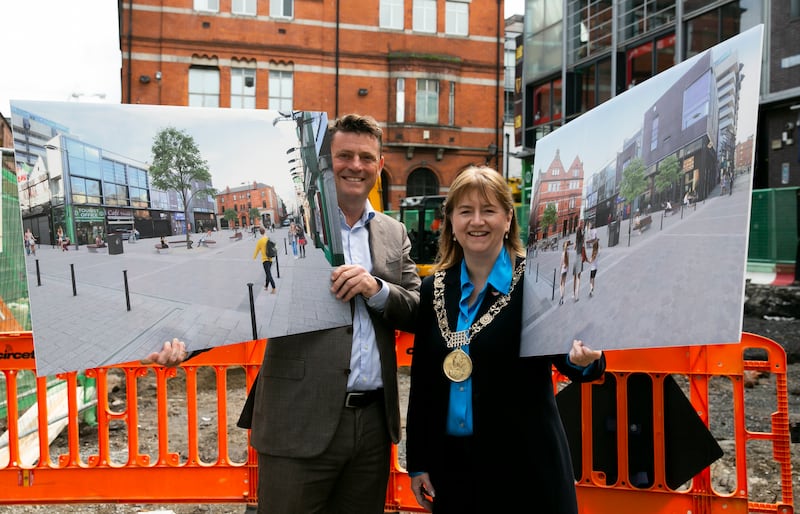A few days before St Patrick’s Day, I found myself in Temple Bar. I was walking from Smithfield to The Irish Times office on Tara Street, through the largely derelict markets area of Dublin 7 (making the obligatory stop to assist some American tourists looking for the Jameson building) down the pedestrianised Capel Street, cutting left from Parliament Street through Temple Bar, eventually popping out at Fleet Street on to Westmoreland Street.
The scrappy atmosphere that takes hold around St Patrick’s Day was evident in Temple Bar; tourists snapping selfies of pints held aloft, the sickly smell of luminous ice-cream, a man dressed as a leprechaun joshing with passersby. All in all, it was pleasant enough. But approaching the central part of Temple Bar where a charming archway leads to Ha’penny Bridge, it was as though the street fell off a cliff. “Oh no,” the friend I was with said, “what the f*** is this?” WTF indeed. What he was referring to was the affront to the eyes that is the “redevelopment” of Temple Bar “Square”.
When the digital imagery of plans for the square was released last year, they were greeted with shock, ridicule and, tellingly, a strange sense of defeat.

The writer Mark O’Connell tweeted at the time that it reminded him “of a great line about Dublin in Emilie Pine and Dead Centre’s play Good Sex: ‘We live in the imagination of some very boring men’.”
READ MORE
The real life version is even worse than the preceding imagery. Bordered by a smattering of vacant units and some battered barrels lined with black sacks pretending to be bins, the “square” or “plaza” or whatever you want to call it is a dull spread of grey slabs. This seeps out on to the now-covered cobblestones, which have been replaced by a curiously incoherent rendering of faux-paving, a version of what a cobblestone might look like if it emerged unset from a jelly mould. This is what an “upgrade” looks like, to use Dublin City Council’s words.
An optimistic view is that perhaps it will take time for all this to come into being, much as the initial pedestrianisation of Capel Street was a mess, until plants, trees and public seating appeared. Arguments about making Temple Bar more accessible are of course relevant. But that accessibility should mean ugliness is unacceptable. The council needs to try far, far harder. What has happened is yet another failure in the public realm.
There is a tendency when discussing urbanism in Ireland to point to cities outside the country, and ask why we can’t have the larger apartments of Berlin, the cafe terraces of Paris, the cycling infrastructure of Amsterdam, and the public space of Copenhagen. But you don’t need to dream continental dreams to consider what could be done better in Dublin city centre. You merely have to hop on a bus or Dart south to the faraway world of Dún Laoghaire.
Recently, councillors in Dún Laoghaire voted to pass the Living Streets scheme. This will involve more pedestrianisation, improved landscaping, planting and seating, quieter and safer roads, outdoor dining, widened footpaths and a reduction in street clutter. Already on George’s Street in Dún Laoghaire there have been beautiful improvements to three shopfronts in particular.
For as long as I can remember, the ambience of Dún Laoghaire – at night – has been eerily quiet and depressed. The town is still plagued by vacant retail units. But during the pandemic, many public-realm improvements were rolled out. Cycle lanes, widened footpaths and public seating, including picnic tables and benches appeared.,Extra bins and public toilets were introduced, and temporary pedestrianisation made streets safer for children and the elderly to stroll. The Living Streets scheme continues this legacy.
[ The Liffey is filthy, but can you imagine if it was clean enough to swim in?Opens in new window ]
What’s strange about what has happened to Temple Bar in this latest instance is that it’s so obvious that it is not an improvement. How did this get over the line? Why didn’t anyone involved stop and think ‘this isn’t good, in fact this is bad’?
By contrast, Dún Laoghaire residents, business-owners, retailers, councillors and council workers are doing interesting things, making improvements to their environment in a sensitive and thoughtful manner. The goal appears to be to make it a better place to live in, be in, work in, socialise in, shop in, visit, and hang out in. The key to what they’re doing is that they’re thinking big. They’re unlocking the potential of a place. Dublin city centre has plenty of potential, but someone has lost the keys.
Temple Bar now has two dead squares. The first is brand new and still under construction. The second is Meeting House Square, which I happen to really like but it’s underutilised and struggles to fulfil any intention of being a vibrant public space.
[ Is it any wonder that Ireland’s public transport is among the worst in Europe?Opens in new window ]
Sure, big projects are afoot, such as the still mythical pedestrianisation of College Green, and plans to restrict vehicle traffic in the city centre, which are welcome. But clearly there is also an imagination deficit. How people feel when they’re navigating a city matters. Meeting ugliness, poor materials and “redevelopments” devoid of fun, beauty and serenity embeds the “this place is a kip” narrative. Shaking my head at yet more grey slabs, it was hard not do the only thing that spares one’s anger and frustration in the moment: walk away.
















